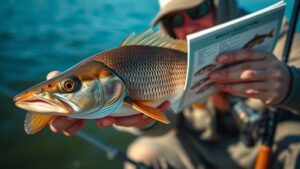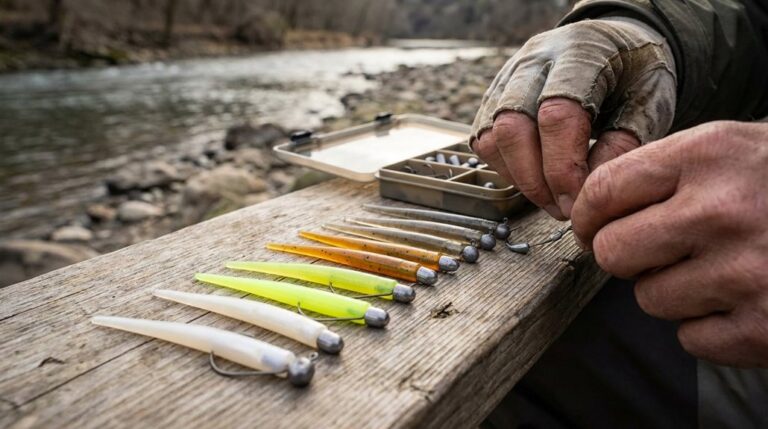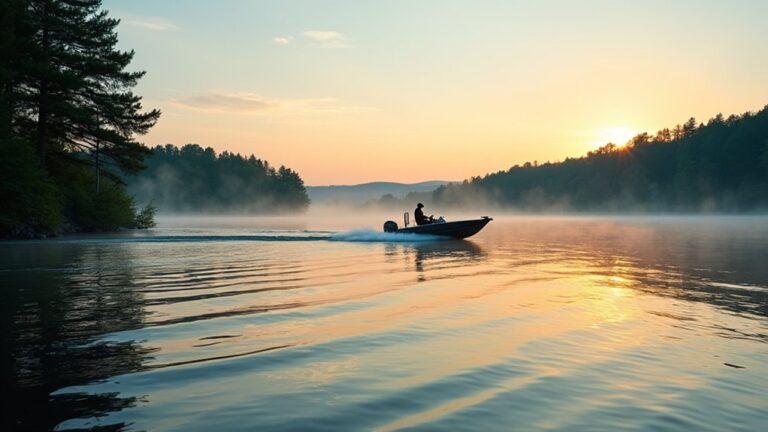To enhance your fishing experience through fish identification, start by understanding basic fish anatomy and key features like body shape, fin structure, and coloration. Familiarize yourself with common species in your area using field guides or mobile apps. Practice your skills regularly by observing fish in various habitats and seasons. Learn about local regulations to guarantee compliance and contribute to conservation efforts. Participate in community workshops or fishing events to gain hands-on experience and share knowledge with fellow anglers. By developing your identification skills, you’ll make better bait selections, choose ideal fishing spots, and ultimately enjoy more successful outings. The more you know, the more rewarding your fishing adventures will become.
Understanding Fish Anatomy
Immerse yourself in the world of fish anatomy to enhance your fishing experience and identification skills. Understanding the basic structures of fish can markedly improve your ability to identify different species and handle them responsibly.
Familiarity with various fishing species and their habitats can also aid in recognizing key anatomical features unique to each type. Start by familiarizing yourself with the key components: the head, trunk, and tail. The head houses essential sensory organs like eyes and nostrils, which fish use for survival and hunting.
Next, focus on the skin covered in scales. These protective structures not only shield fish from parasites and physical damage but also contribute to their efficient swimming.
You’ll find gills on either side of the head, critical for oxygen extraction from water. Don’t forget the swim bladder, an internal organ that helps fish maintain buoyancy and conserve energy.
Key Identification Features
A sharp eye for detail is vital when identifying fish species. As an angler, you’ll need to focus on several key identification features to accurately distinguish between different fish. Body shape, fin structure, coloration, and size are important elements to observe.
Many fish species have unique markings or patterns, like stripes or spots, which can help you tell them apart from similar-looking species. Understanding the key identification features of saltwater fish can further enhance your skills.
When trying to identify a fish, consider its habitat. The location where you’ve caught it can provide valuable clues, as certain species are adapted to specific environments such as freshwater, saltwater, or brackish waters. Knowing the typical size range for different species is also important, as it can help you quickly determine if your catch is within legal limits or if it might be a different species altogether.
To improve your fish identification skills, make use of identification guides. These resources often include detailed illustrations and descriptions of distinguishing traits, which can greatly enhance your ability to correctly identify various fish species.
Common Fishing Locations

While identifying fish species is important, knowing where to find them is equally valuable. When searching for the perfect fishing location, consider these common fishing locations:
- Coastal areas and estuaries
- Rivers and lakes
- Structures like reefs, submerged rocks, and fallen trees
Florida’s 1,350-mile coastline offers diverse habitats for saltwater fishing enthusiasts, providing access to various migratory fish species.
You’ll find a wide variety of fish species where two water bodies meet, such as inlets or estuaries, making these areas prime fishing spots due to the convergence of different ecosystems.
Additionally, seasonal highlights for fishing can greatly influence your catch.
For freshwater fishing, rivers and lakes provide excellent opportunities.
Look for areas with submerged structures, as they serve as shelter and feeding grounds for many fish species. These spots often attract a higher concentration of fish, increasing your chances of a successful catch.
To enhance your fishing experience, take advantage of local resources.
Bait shops and fishing forums can provide valuable insights into seasonal changes and fish behavior. They can guide you to the best fishing locations based on current conditions.
Additionally, seek out designated fishing areas, piers, and parks that offer easy access for anglers of all skill levels.
Seasonal Fish Behavior
Throughout the year, fish behavior and feeding patterns undergo notable changes, directly impacting your fishing success. Understanding these seasonal changes is essential for adapting your techniques and improving your catch rates.
In spring, you’ll notice increased activity as many fish species, like bass and trout, prepare for spawning.
As water temperatures rise in summer, you’ll find catfish and panfish becoming more active in shallower waters, while larger predators like pike seek cooler, deeper areas.
Fall brings a feeding frenzy as fish populations bulk up for winter, making it an ideal time to target species such as walleye and musky.
Winter presents unique challenges, with fish metabolism slowing down in colder waters. Many species become lethargic and move to deeper areas, requiring you to adjust your approach for successful fishing.
Additionally, being aware of migratory patterns, like salmon spawning runs in fall, can greatly boost your chances of a great catch.
Regulatory Compliance Through Identification
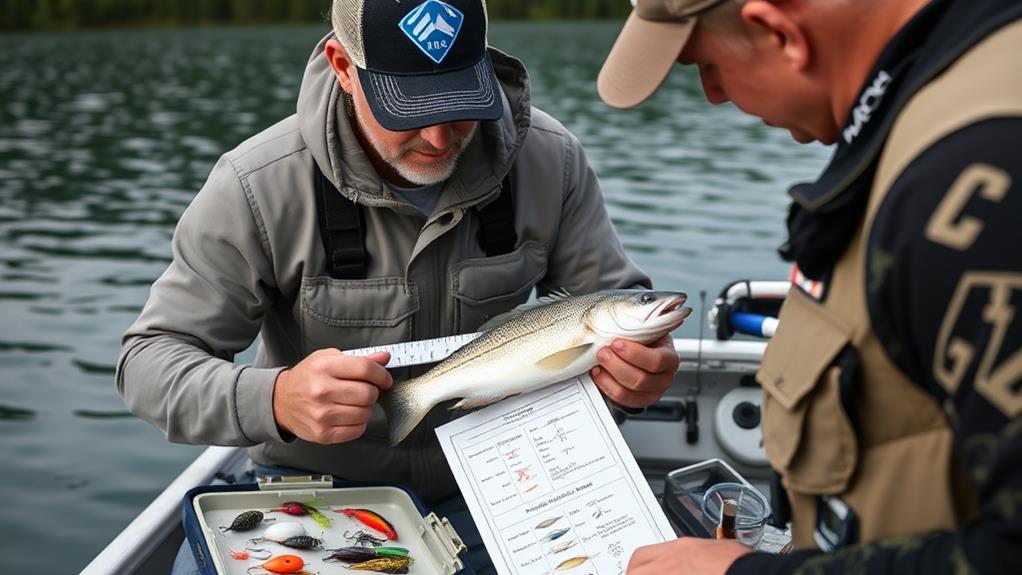
Proper fish identification is vital for regulatory compliance in fishing. As an angler, you’re responsible for understanding and adhering to specific size and bag limits for different species. By honing your identification skills, you’ll avoid unintentional violations and contribute to conservation efforts.
To improve your fish identification abilities and guarantee regulatory compliance:
- Obtain local fish identification guides from state agencies.
- Study distinguishing traits and habitats of common species in your area.
- Participate in community programs and provide feedback on fisheries management issues.
These steps will help you recognize protected species and make informed decisions about your catches. Remember, some fish may be entirely off-limits, making accurate identification fundamental to avoid illegal catches.
Your fishing license comes with the responsibility to fish responsibly and adhere to fishing regulations. By familiarizing yourself with the local species and their specific rules, you’ll enhance your angling experience while supporting sustainable practices.
Don’t hesitate to engage with fellow anglers and local authorities to stay informed about any changes in regulations or emerging conservation concerns. Your active participation in fish identification and regulatory compliance contributes to the long-term health of our fisheries.
Tools for Accurate Fish Recognition
Accurate fish identification is a skill that can be honed with the right tools. To enhance your ability to recognize local species and comply with fishing regulations, you’ll want to leverage various resources at your disposal.
Start by obtaining fish identification guides from your state wildlife agency. These guides are tailored to your area’s aquatic life and often include information on fishing regulations.
For instant access to species information, download mobile apps dedicated to fish identification. These apps can provide details on distinguishing features, size, and habitat preferences of local fish.
When you’re out on the water, carry a pocket-sized field guide with illustrations of local species. This will help you quickly reference and compare your catch to known fish types.
Pay close attention to physical characteristics such as body shape, coloration, and fin placement when examining your catch.
To further improve your identification skills, participate in local fishing workshops or clinics. These hands-on experiences will deepen your understanding of the aquatic ecosystem and provide valuable practice in recognizing different species.
Practicing Identification Skills
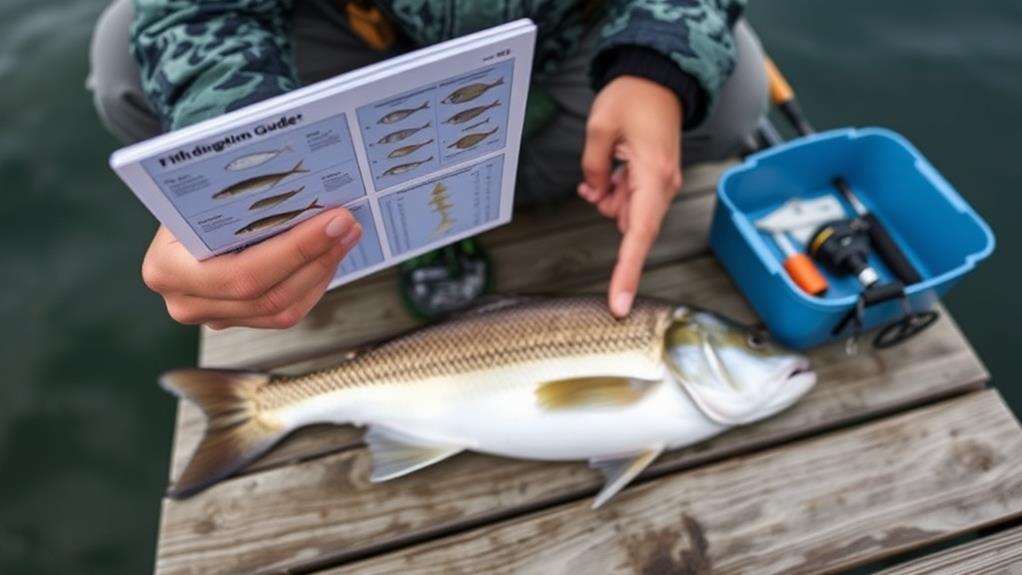
How can you sharpen your fish identification skills? Practice is key to becoming proficient in recognizing various fish species. Start by familiarizing yourself with local fish using identification guides that highlight distinguishing traits, sizes, and habitats. This knowledge will enhance your fishing techniques and help you comply with fishing regulations.
To improve your skills, focus on these practical steps:
- Identify common freshwater species like largemouth bass, bluegill, and catfish.
- Use mobile apps or field guides with illustrations and descriptions for real-time identification.
- Participate in community workshops or programs led by expert anglers.
Regularly review fishing regulations specific to your area, as understanding protected species and size limits is essential for responsible angling.
By actively engaging in these practices, you’ll develop a keen eye for fish identification, which will greatly enhance your overall fishing experience.
Don’t hesitate to challenge yourself by learning about less common species in your region. The more you practice, the more confident you’ll become in accurately identifying your catches and making informed decisions about bait selection and fishing locations.
Conclusion
You’ve now become an expert in fish identification, armed with knowledge of anatomy, seasonal behaviors, and regulatory requirements. Ironically, as you perfect your ability to recognize every fin and scale, you’ll find yourself spending more time admiring the fish than actually catching them. But don’t worry, your newfound expertise won’t go to waste—you’ll be the go-to person at the dock for settling debates about that “monster catch” that got away.

